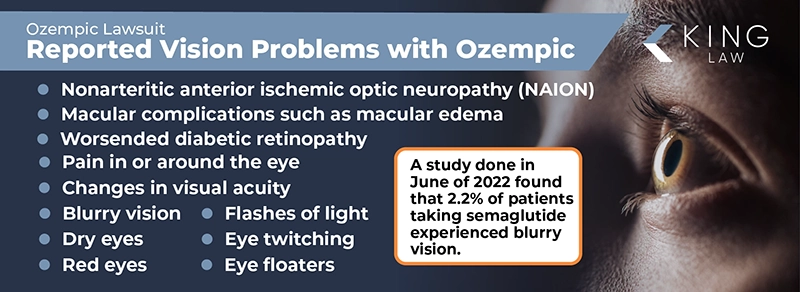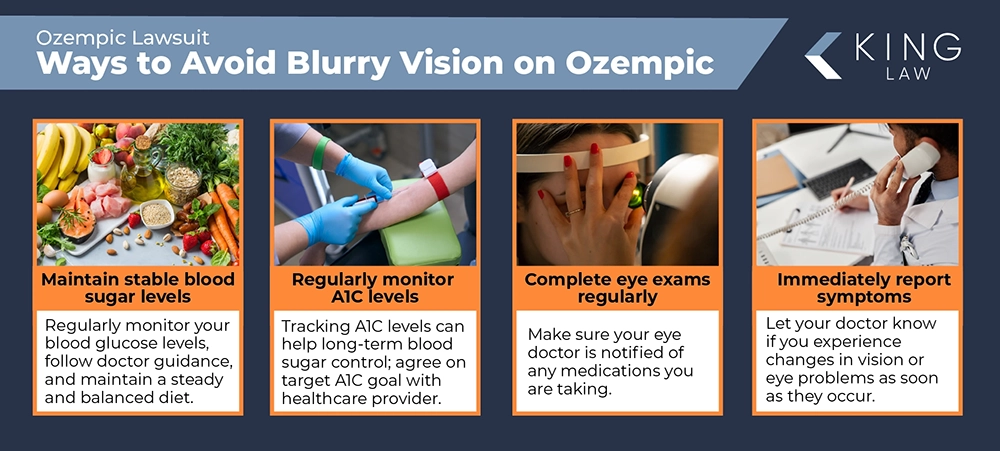
Ozempic and Blurred Vision Overview
According to May 2024 survey data, around one in eight individuals have taken a GLP-1 agonist medication such as Ozempic. Over the past three to five years, Ozempic, Wegovy, and Rybelsus have gained substantial popularity. While many of these drugs are used to treat type 2 diabetes, some are also being used for weight loss in patients who are overweight or obese.
Despite the potential benefits of these medications, more and more reports are emerging of serious health effects. Patients on Ozempic have dealt with vision changes, blurry visions, eye floaters, and now blindness. If you take Ozempic and experience an extreme side effect, you may be able to file an Ozempic blindness lawsuit to recover compensation.
Boston Researchers Link Semaglutide to Blurry Vision, Blindness, and Vision Loss
A new study by Mass Eye and Ear, a teaching hospital of Harvard University, found a strong correlation between semaglutide (Ozempic’s active ingredient) and a rare condition that causes blindness in one eye. This condition, non-arteritic anterior ischemic optic neuropathy (NAION) can be permanent and there are no known treatment options. The study found:
- Patients with diabetes who took semaglutide were more than four times more likely to develop NAION than those on other medications.
- Patients who were obese and took semaglutide were more than eight times more likely to develop NAION than those on other medications.
Researchers concluded, “Our main finding is that prescribed semaglutide is associated with an increased risk of NAION.” They also acknowledged the need for further research as this study wasn’t enough to prove a causal relationship between Ozempic and blindness. Symptoms of NAION can include:
- Sudden blindness in one eye
- Blurry vision
- Color distortion
- Loss of peripheral vision
- Loss of contrast
- Light sensitivity
- Dark or gray spot in vision that doesn’t move
Patients taking semaglutide should maintain regular eye checkups and notify their doctor of all medications they’re taking. If any abnormal symptoms should arise, patients should seek medical care as soon as possible.
About Ozempic and Blurred Vision:
Can Ozempic Cause Blurry Vision?
How Does Ozempic Affect Vision?
Reported Vision Problems With Ozempic
How Often Do Ozempic Users Report Blurry Vision?
Can Blurry Vision Lead to Blindness?
Can Blurred Vision From Ozempic Be Reversed?
Ways to Avoid Blurry Vision While Taking Ozempic
Other Semaglutide Medications Associated with Blurry Vision
Can Ozempic Cause Blurry Vision?
Many patients have reported blurry vision while taking Ozempic. Vision changes are listed as a potential Ozempic side effect and patients are experiencing it. Furthermore, studies have confirmed eye-related symptoms. A large 2020 study concluded, “Ozempic is associated with higher rates of diabetic retinopathy and adverse ocular events compared to other GLP-1 receptor agonists.” Specifically:
- A 2020 study reviewing back to 2018 looked at 2,109 adverse events associated with Ozempic. Of those 2,109, there were 140 notable adverse ocular events.
- Adverse ocular events included 47 cases of blurred vision (33.6%), 23 cases of diabetic retinopathy (16.4%), and 4 (2.9%) cases of macular complications.
- The total number of adverse ocular events was “significantly higher” for Ozempic versus other GLP-1 medications.
- For Ozempic, reported cases of diabetic retinopathy were 16.4% compared to 2.3%-6.3% for other medications, and other adverse ocular events were 1.1% for Ozempic and 0.05%-0.19% for other medications.
Patients have experienced trouble driving at night, issues with their peripheral vision, extreme eye irritation, and other effects that impact their ability to see and go about their day-to-day life.
How Does Ozempic Affect Vision?
There are various ways Ozempic can be connected to vision changes, many of which are associated with blood sugar management. Semaglutide, the active ingredient in Ozempic, releases a GLP-1 hormone that promotes feeling full to ultimately reduce blood sugar levels. Changing blood glucose levels can impact the body in many ways, including the eyes.
Potential causes of Ozempic-related vision changes include:
- Changes in blood sugar can cause swelling of your eye lens and change its shape, causing blurred vision. Older individuals are often more susceptible to this because their eye lens is less flexible.
- Ozempic has been linked to NAION, which has a symptom of blurry vision. It’s unclear how Ozempic is connected to NAION, but it could be because of blood pressure changes, inflammation, rapid blood sugar changes, and other scenarios that impact blood flow to the optic nerve.
- Some patients have experienced worsening diabetic retinopathy when taking semaglutide, which also has blurred vision as a side effect.
- Ozempic can cause vomiting and diarrhea, which can lead to dehydration and therefore blurry vision.
- Some patients taking semaglutide have experienced macular complications such as macular edema, which can cause blurry vision.
Patients should report any side effects to their doctor as soon as possible. Legal action may also be a possibility, especially if patients feel they weren’t adequately warned about a severe side effect.
Reported Vision Problems With Ozempic
There are numerous vision problems Ozempic patients have experienced, including:
- Worsened diabetic retinopathy
- Nonarteritic anterior ischemic optic neuropathy (NAION)
- Macular complications such as macular edema
- Blurry vision
- Dry eyes
- Red eyes
- Pain in or around the eye
- Changes in visual acuity
- Eye floaters
- Flashes of light
- Eye pressure
- Eye twitching
Symptom severity can vary greatly from patient to patient but should always be taken seriously and reported to a medical care provider.

How Often Do Ozempic Users Report Blurry Vision?
The June 2020 study looking at adverse eye-related side effects of Ozempic focused on 2,109 cases. Of those 2,109, there were 140 reports of ocular events, 47 of which were reports of blurred vision. Based on these numbers, 2.2% of patients taking semaglutide experienced blurry vision.
One news outlet reported on a case where a woman took Ozempic and experienced extreme changes in her vision hours after taking her third dose. “Like somebody threw a switch,” she could no longer legally drive at night, had trouble reading street signs, and was seeing halos. Her doctor noted that many people experience vision changes on Ozempic and there are likely many more cases that haven’t been reported. She reported her experience to Novo Nordisk and to the FDA.
Can Blurry Vision Lead to Blindness?
In some cases, blurry vision can lead to blindness. There are many eye problems related to Ozempic where blurred eyesight is a common side effect. If left untreated, these eye problems can cause irreparable damage and ultimately, blindness. Some of the most serious related eye problems include:
- Changing blood sugar levels: Changing blood sugar levels can impact the eye lens shape and clarity of vision. Vision changes should subside when blood sugar is regulated, but if blood sugar issues go unmanaged, vision issues can continue and worsen.
- Diabetic retinopathy: If left untreated, abnormal blood vessels can grow on the retina and cause bleeding, scarring, and retinal detachment. Advanced diabetic retinopathy is linked to significant vision loss.
- Macular edema: Chronic macular edema can permanently damage the macula and cause central vision loss, leading to significant visual impairment or blindness.
- Non-arteritic anterior ischemic optic neuropathy (NAION): In addition to vision loss or blindness in one eye, NAION can recur in the second eye leading to additional vision loss or complete blindness.
Monitoring for symptoms and regular eye exams can help patients prevent further complications and begin treatment as soon as possible.
Can Blurred Vision From Ozempic Be Reversed?
Depending on the cause of blurred vision related to Ozempic, patients may be able to reverse their symptoms:
- Changing blood sugar levels: Once blood sugar levels stabilize, lens swelling should subside and vision should clear. If it doesn’t, there may be another issue at play.
- Diabetic retinopathy: If caught in its early stages, treatment and regulation of blood sugar levels can stop and potentially reverse vision changes. If the condition worsens, it can cause permanent, irreversible damage.
- Macular edema: Less severe cases may be treated with medications, laser therapy, or injections that improve swelling and vision. More severe cases may cause irreversible damage.
- Non-arteritic anterior ischemic optic neuropathy (NAION): Vision loss in one eye from NAION is usually permanent. However, some patients experience partial recovery.
In some cases, patients may need to discontinue their medication if it’s not working to manage their diabetes or it’s contributing to problematic side effects.
Ways to Avoid Blurry Vision While Taking Ozempic
There are some ways patients may be able to prevent blurry vision associated with Ozempic, such as:
- Maintain stable blood sugar levels: Regularly monitor your blood glucose levels, follow your doctor’s guidance, and maintain a balanced and consistent diet to avoid sharp spikes or drops in blood sugar.
- Regularly monitor A1C levels: Keep track of your A1C levels to maintain long-term blood sugar control and stay within your target A1C range as agreed upon with your healthcare physician.
- Complete regular eye exams: Notify your eye doctor of any medications you’re on and go to all of your scheduled eye exams (at least once a year) to help ensure early detection of serious eye conditions like diabetic retinopathy or macular edema.
- Report symptoms immediately: Let your medical provider know immediately if you experience changes to your vision or problems with your eyes to help prevent long-term damage.
Patients should take their medication as prescribed and follow their doctor’s instructions to discontinue if needed.

Other Semaglutide Medications Associated with Blurry Vision
Ozempic is not the only semaglutide medication associated with blurred vision. Wegovy and Rybelsus, both of which have semaglutide as their active ingredient, have also impacted patient vision. Reported symptoms are similar to those of Ozempic and likely correlated to changes in blood sugar. Studies suggest that Wegovy and Rybelsus may also worsen diabetic retinopathy and macular complications.
Have You Noticed Blurred Vision While Using Ozempic?
If you experience any type of vision changes when taking Ozempic, notify your healthcare provider. Seek care immediately if you experience severe symptoms like blindness or sudden vision loss. Other symptoms may include dry eyes, eye twitching, eye redness, eye pain, eye floaters, flashes of light, and light sensitivity. In addition to receiving medical care, you may also consider reaching out to an attorney.
Novo Nordisk, the manufacturer of Ozempic, has been facing an onslaught of lawsuits after not adequately warning consumers of serious side effects like stomach paralysis and intestinal blockages. With blindness now a concern, individuals are seeking legal action through personal injury lawsuits to hold the drug manufacturer responsible and recover compensation that can be used for medical bills, lost wages, and other damages.
Contact an Ozempic Lawyer
If you’ve been negatively impacted by a semaglutide medication, reach out to an experienced lawyer as soon as possible. To file an Ozempic lawsuit, you must adhere to state-specific statutes of limitations, which often allow only 2-3 years from your diagnosis or injury to file a claim. Keep in mind: Novo Nordisk, like many other drug manufacturers, has fought against claims that they didn’t warn consumers of severe medication risks. The manufacturer insists that the new Harvard study connecting Ozempic to NAION is insufficient. Many plaintiffs take issue with pharmaceutical giants who seemingly prioritize profits over public safety, which is why legal action can be crucial to holding manufacturers responsible and protecting future parties.
To ensure you don’t miss your chance for justice and compensation, contact a lawyer experienced in handling cases involving Ozempic or other semaglutide drugs and serious side effects like blindness, stomach paralysis, and intestinal blockages. King Law is an excellent choice, known for its strong background in handling such cases and dedication to securing justice for claimants.
Frequently Asked Questions (FAQs)
Get more information on Ozempic and blurred vision with these FAQs.

